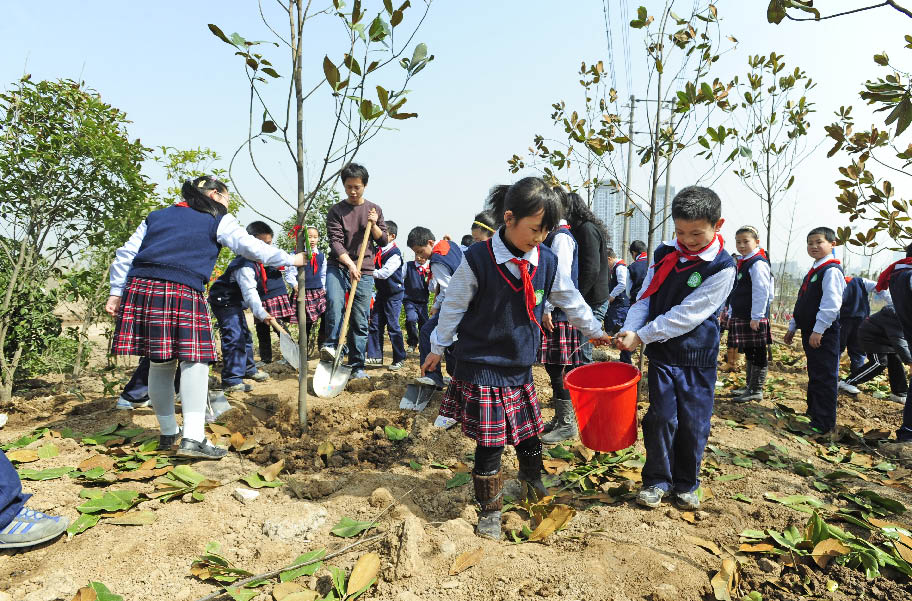| Doing the Right Thing
China tackles climate change while still a developing country
By LUO QI
CHINA still faces tough challenges as a participant in international cooperation on climate change. A big problem in this regard is its developing-country status – one that has been questioned by some countries, according to Pan Jiahua, president of the Center for Urban Development and Environment and director of the Research Center for Sustainable Development at the Chinese Academy of Social Sciences.
 |
| More than 400 green volunteers, many of them children, planted trees in Nanjing, Jiangsu on March 17, 2010. China Foto Press |
Based on a principle of "common but differentiated responsibilities," developing countries are allowed to give priority to their growth, while at the same time exploring a low-carbon path with the financial and technical help of developed countries. As a developing country, China needs developed countries to provide financial aid and make technology transfers to move towards this environment-friendly goal. Some developed countries, and even some developing ones are maintaining the position that China is no longer a developing country.
Their arguments for China's reclassification are as follows.
First: China has surpassed Japan as the world's second largest economy.
Second: China's foreign exchange reserves, exceeding US $2 trillion, have jumped to No.1 in the world.
Third: China's fiscal revenue has maintained an average annual growth of over 20 percent and the 2010 fiscal revenue is expected to hit RMB 8 trillion.
Fourth: China has seen rapid development over the past few decades, with people in some regions enjoying real prosperity.
However, what they see is only one side of China; judged as a whole, China is still a developing country.
"China's per capita GDP ranks below the top 100 countries in the world; in terms of social development, China is in 92nd place on the 2009 Human Development Index list compiled by the UN Development Program (UNDP). Those rankings are legitimate evidence of China's true standing with respect to the world's major economies. In addition, Pan's analysis shows, "China lags far behind developed countries in terms of institutions and other cohesive mechanisms."
Pan believes that as a developing country, China should focus on its development.
But China also sets great store by responding to climate change issues as a means to achieve sustainable development for future generations. It has set itself targets that by 2020 will improve on 2005 levels in four key areas: reduce carbon dioxide emissions by 40 to 45 percent per unit of GDP, raise the use of non-fossil energy to 15 percent of primary energy consumption, increase its forests by 40 million hectares, and their growing stock by 1.3 billion cubic meters.
To achieve those goals, China has adopted various measures, but international cooperation is also needed to tackle this issue. China's control over its own progress has limits. The country is still in the middle stages – albeit rapid – of industrialization and urbanization. For quite a long period therefore, its total energy consumption will of necessity keep on rising. Currently the proportion of fossil fuel in its total energy mix is about 91 percent. Although China has dedicated a lot of manpower and money to renewable energy development (mainly referring to wind, solar and biomass energy), the proportion of the country's total energy consumption this satisfies will increase very little by 2020, chiefly due to significant overall growth, according to Lin Erda, director of the Agricultural and Climate Change Research Center of the Chinese Academy of Agricultural Sciences. These projections reflect China's actual conditions and they differentiate China from the developed countries of Europe.
Pan Jiahua also notes that China approved the target of limiting the global temperature rise to within 2 degrees Celsius, as set by the Copenhagen Accord, but opposes the target of reducing global emissions to 50 percent of 1990 levels by 2050. As a developing country, its energy consumption and greenhouse gas emissions will both climb, but China has set its low-carbon development target and adopted a series of related policies and measures.
China is devoted to achieving a low-carbon economy and reducing carbon dioxide emissions per unit GDP for a host of reasons – tackling climate change, guaranteeing energy security and promoting sustainable development included. Pan emphasizes that China needs understanding and support from the international community in its efforts to balance acceleration of growth while cutting carbon emissions. It can't be stressed enough that China's problem is also in part the world's problem, and tackling climate change demands concerted worldwide effort.
| 